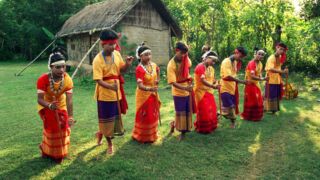Bengali cuisine is the culinary style of the Bengal region in the eastern part of the Indian subcontinent in Bangladesh and the Indian states of West Bengal, Tripura and Assam’s Barak Valley. There is an emphasis on fish, vegetables and lentils with rice as the main ingredient. Many Bengali food traditions draw on social activities, such as adda or the Mezban.
Bengali cuisine in Bangladesh is known for the varied use of flavors as well as the spread of its confectionery and desserts. It has the only traditionally developed multi-course tradition of the cuisine of the Indian subcontinent that is analogous in structure to the modern Russian-style service of French cuisine, where food is served in courses rather than in one sitting.
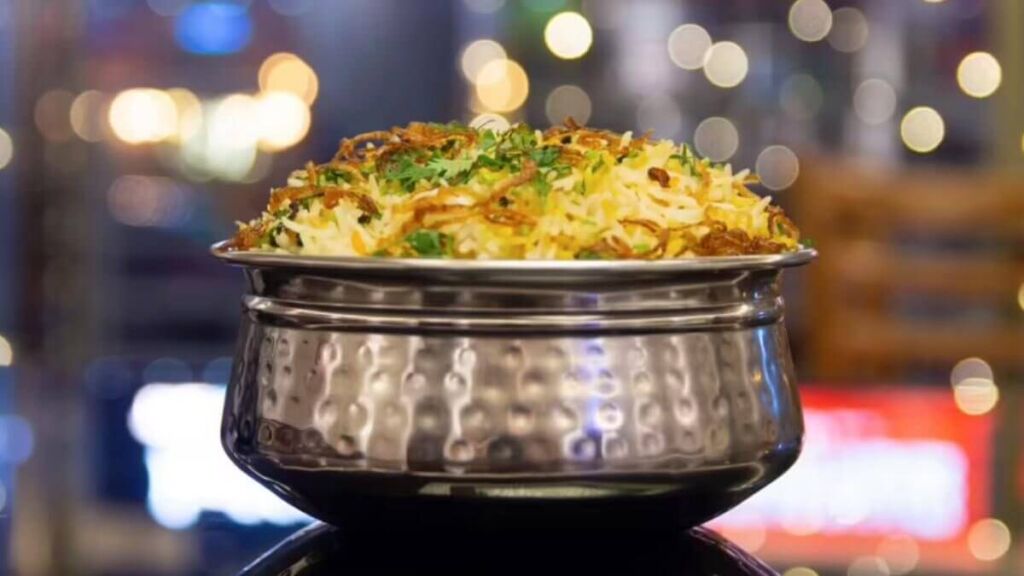
Muslims conquered Bengal around the middle of the thirteenth century, bringing with them Persian culture and cuisine to what is now Bangladesh. Islamic culinary influence originated from the upper classes and gradually spread to the local Hindu and poorer Muslim population. Dishes like biryani, korma and bhuna had once been meals of the higher courts, but Mughal cooks brought their recipes to the lower and middle classes. Its influence was strengthened during the rule of the British Raj, where Kolkata became the refuge for many prominent exiled Nawabs. The exiles brought with them hundreds of cooks and masalchis (spice mixers), and as their royal patronage and wealth waned, they dispersed among the local population. These cooks came with the knowledge of a very wide variety of spices (particularly jafran and mace), the extensive use of ghee, and the marinating of meats with yogurt and chili.
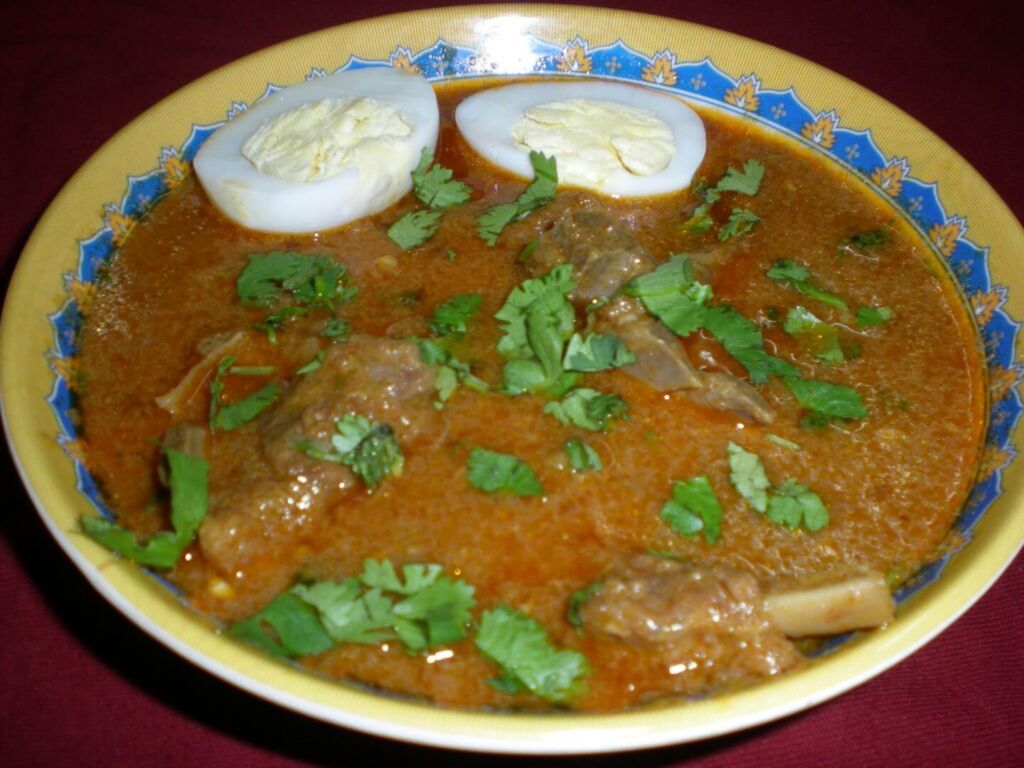
In Bangladesh, this food has become a common dish for the population, while in West Bengal they have remained the food of professional chefs. Further innovations include chap (ribs slow cooked on a tawa), rezala (meat in a thin yogurt and cardamom gravy) and kathirol (kebab in a wrap).
The Mughals had a particular fixation on meat, introducing mutton into mainstream Bengali cuisine as well as already familiar meats such as chicken and venison. In addition, traditional desserts were mainly based on rice pastes and jaggery, but under Mughal influence they evolved towards significantly increased use of milk, cream and sugar along with expensive spices such as cardamom and saffron.
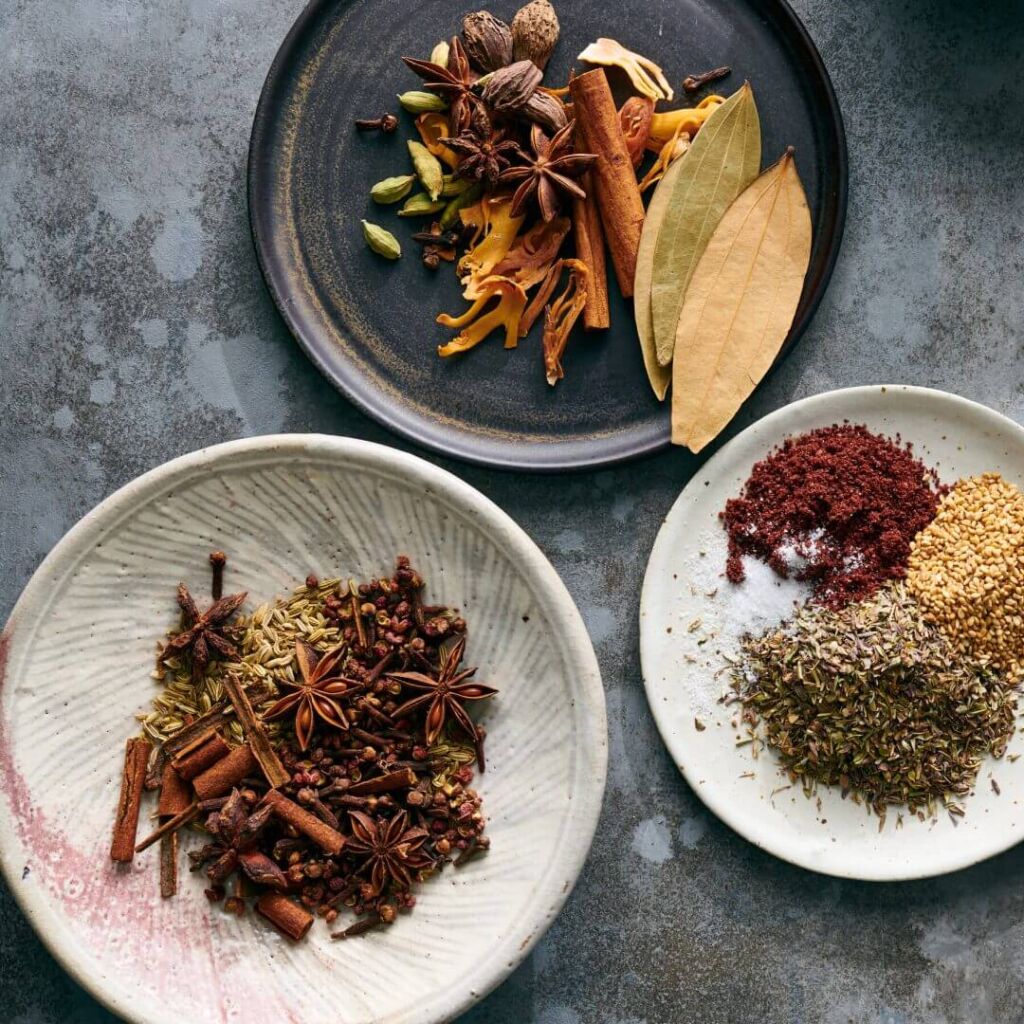
In the Hindu patriarchal tradition, widows are not allowed to eat foods that would not be classified as “bitter”, requiring experimentation and innovation. While most Bengali castes ate meat and fish, it was forbidden for widows. Widows also could not use “warming” foods such as shallot and garlic, but ginger was allowed. This style found a core place in Bengali curries in general, both vegetarian and non-vegetarian. Expensive spices such as saffron, cinnamon, or cloves were used very sparingly, if at all. Nuts, dried fruit, milk and milk products (such as cream, ghee or curd) were also scarce. These economic and social constraints influenced Bengali widows to create a whole new set of meals that used only vegetables and cheap spices.
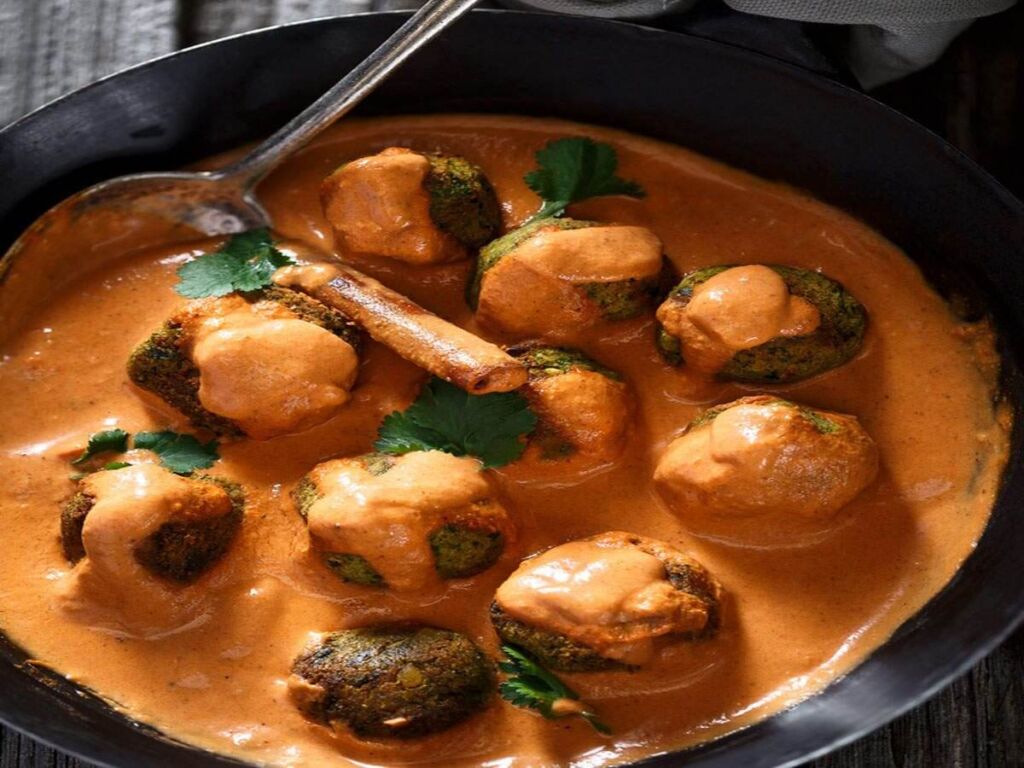
Anglo-Indian food is not merely the result of British influence. Once home to a French colony, Bengal and nowadays Bangladesh was also home to populations of Portuguese, Dutch, and other Europeans. These collective Western influences can be found in the foods that are made to suit the tastes of Western rulers. The result is a unique cuisine, local ingredients adapted to French and Italian cooking techniques – characterized by creamy sauces, restrained use of spices and new techniques such as baking. English and Jewish bakers such as Flury’s and Nahoum’s dominated the confectionery industry which migrated from British tables to everyday Bengali, resulting in unique creations such as the pêţis (savory turnover, from the English “pasty”). Another enduring contribution to Bengali cuisine is pau ruţi, or Western-style bread. Raj-era cuisine lives on in Bangladesh, especially in the variety of appetizers, such as mutton, kabiraji cutlet, or fish orly.
The British also influenced food in a somewhat different way. Many British hired local chefs and discovered local food through them. The food had to be watered down or adapted to the taste of the “memsahibs”. The most pronounced influence can be seen in the desserts, many of which were created especially to please the British – notably the very popular sweet leđikeni named after the first Vicereine Lady Canning; it is a derivative of the pantua made for an event organized by her.
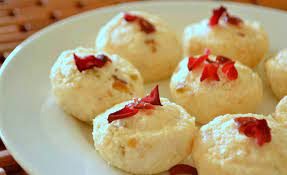
The Chinese of Kolkata originally settled in a village called Achipur south of Kolkata in the late 18th century, later moving to the city and finally to their present home in Tangra on the eastern outskirts of Kolkata. The inhabitants of Kolkata of Chinese descent form a substantial and successful community with a clear identity. With this identity that came Chinese food, which is currently available on almost every street corner in Kolkata, due to its taste, quick cooking process and no resemblance to the original Chinese recipe other than the use of soy sauce. It was mainly Cantonese merchants and sailors who first settled here and decided to cook with whatever they had on hand.
Over time, the influence of this cuisine became widespread throughout the region; it is available as “Chinese” food in every city in India and bangladesh. Bangladeshi immigrants to other countries have started taking this abroad as well. Indian-Chinese restaurants have popped up in many places in the United States and the UK.
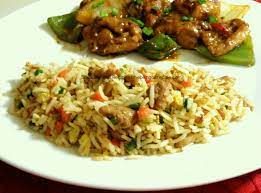
Indian Chinese food received a second boost in popularity since the 1950s, when a large number of Tibetans migrated to Indian Territory after the flight of the 14th Dalai Lama. Tibetans brought their own taste preferences to add to the genre, such as the popular momo (a type of dumpling) or thukpa (a hearty noodle soup). Tibetans and Nepalese immigrants found work in the many kitchens that can now be found on almost every street in Kolkata. The chop suey became a favorite, and versions like “American chop suey” and “Chinese chop suey” were constantly discussed.
The large-scale movement along religious lines as a result of the partition led to changes in the consumption of meals to conform to religious restrictions. In Bangladesh (former East Bengal and East Pakistan), Mughlai food is common, as well as foods less popular in West Bengal, such as beef kebab. In addition, more traditionally Islamic sweets such as zarda and firni-payesh are eaten. In rural Bangladesh, many people eat fried, puffed or raw makna. In West Bengal, the only restriction is beef, which only applies to Hindus.
Bengali cuisine can be divided into four different types of dishes, charbya (Bengali: চর্ব্য) or chewed foods such as rice or fish; choṣya (Bengali: চোষ্য), or food that is sucked, such as ambal and tak; lehya (Bengali: লেহ্য), or food intended to be licked, such as chutney; and peya (Bengali: পেয়), which includes drinks, mainly milk.
Specialties of Chittagong
Mezban celebrations are popular throughout the area, where characteristic “heavy” dishes – dishes rich in animal fat and dairy products – are served. Sea fish and seafood are quite common in these areas. Shutki is more widely available in this region than in other parts of the country.

Specialties of Dhaka
The Nawabs of Dhaka had brought Mughlai cuisine to Bengal, and with it many Islamic elements that were fully preserved by the culinary community of Bangladesh. Due to the high cost of producing Mughlai food, the recipes were limited to the elite classes in colonial India and expanded slowly as Bangladesh’s economy grew. The main focus on lamb, mutton, beef, yogurt and mild spices define the flavor of the style. Such dishes as kebab; stuffed breads; kachi biriyani ; roast lamb, duck and chicken; patishapta ; Kashmiri tea; and korma are still served on special occasions such as Eid and weddings. Due to the high class of the food, using an excessive amount of expensive ingredients such as ghee and melting the food in the mouth were essential to the feel of the food.
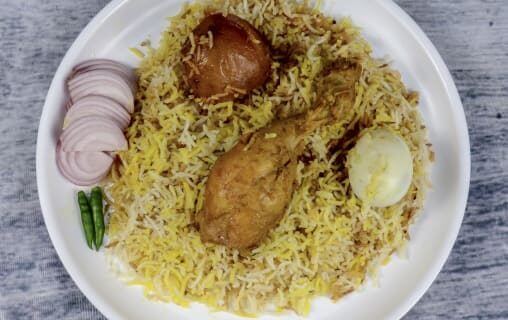
Bengals usually eat sitting on the ground. They traditionally eat without cutlery, with a large banana or plantain leaf as a plate, or with plates made of dried sage leaves sewn together.
It is customary to offer guests food and drinks appropriate to the time of their visit. At meals, guests are served first, with the possible exception of very old or very young members of the host family. Within the family, service begins with the elder men (those of the highest social rank or oldest). School age children are served before wives, daughter-in-law and the cook, who are the last to eat.
Before colonization, observance of the meal order was a hallmark of social status, but with British and Portuguese influence and the growth of the middle class, this has slowly disappeared. Courses are often skipped or combined with daily meals. Meals were usually served to the diners by the youngest housewives
rebounded, but the increasing influence of nuclear families and urbanization have replaced it. It is customary to place everything on dishes in the center of the table, and each diner serves itself. Ceremonial occasions such as weddings used to have elaborate serving rituals, but professional catering and buffet-style dinners are now commonplace. However, these rules can still be observed at large family gatherings and more lavish ceremonial celebrations.
Daily meals are usually simple, with a balanced diet and a lot of vegetables are used. The courses generally go from lighter to richer and heavier and go through different flavors and taste cleaners. Rice remains common throughout the meal and is the main ingredient of the meal, right up to the chaţni (chutney) course.
Appetizer or appetizer
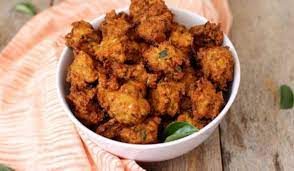
Shukto
The starter dish is made from bitter vegetables or herbs, often fried in oil or steamed with diced potatoes. Portions are usually small – a spoonful or so for rice – and this course is considered both a flavor cleanser and of great medicinal value. The ingredients used for this course change seasonally, but common ones are kôrola or uchhe (forms of bitter gourd) which are available almost all year round, or soft neem leaves in the spring.
A thick soupy mixture of vegetables in a ginger-mustard sauce called Shukto in West Bengal usually follows the bitter starter course, but sometimes replaces it altogether as an appetizer. Shukto is eaten in much larger portions and is usually eaten in summer. It’s a complex dish, with a fine balance of many different flavors and textures, and is often a critical measure of a Bangladeshi chef’s skills in the kitchen.
Shak
The first course is then followed by shak (leaf greens) such as spinach, palong chard, methi fenugreek, or amaranth, to name a few. The shak can be steamed or cooked in oil with other vegetables such as started (eggplant). Steamed shak is sometimes accompanied by a tart paste of fermented mustard seeds, spices and sometimes dried mangoes, dried Indian plums and olives called Kashundi. Many varieties of the Shak (fried/boiled leaves) are tasted in Bengal. Methi Shak, Kormi Shak, Pui Shak, Ponka Shak, Kulekhara Shak, Sojne Shak (drumstick leaves), Hinche Shak, Neem Pata, Lau Shak, Kumro Shak, Sorshe Shak (also very common in North India), Kochu Shak etc are some of the varieties that are very commonly eaten in Bengali dishes. Neem Shak and Begun (Brinjal) is cooked in mustard oil (deep fried) and consumed with rice. This is a unique dish that is consumed as a normal food because of the bitter taste due to the neem leaves.
Dal
The đal course is usually the most substantial course, especially in West Bengal. It is eaten with a generous portion of rice and some garnishes. Common side dishes at đal include aaloo bhaate (mashed potatoes with rice) and bhaja (stir-fried). Bhaja literally means ‘fried’; most vegetables are good candidates, but started (eggplants), kumro (pumpkins) or alu (potatoes) like chips, or shredded and fried, uchhe, potol-pointed gourds are common. Maach bhaja (fried fish) is also common, especially rui (rohu) and ilish (hilsa). Bhaja is sometimes topped with a beshon (chickpea flour) and posto (poppy seed) batter. A close cousin of bhaja is bôra or fried savory balls, usually made from poshto (poppy seed) paste or coconut mince. Another variant is fried pointed gourd as potoler eaves with roe or shrimp.
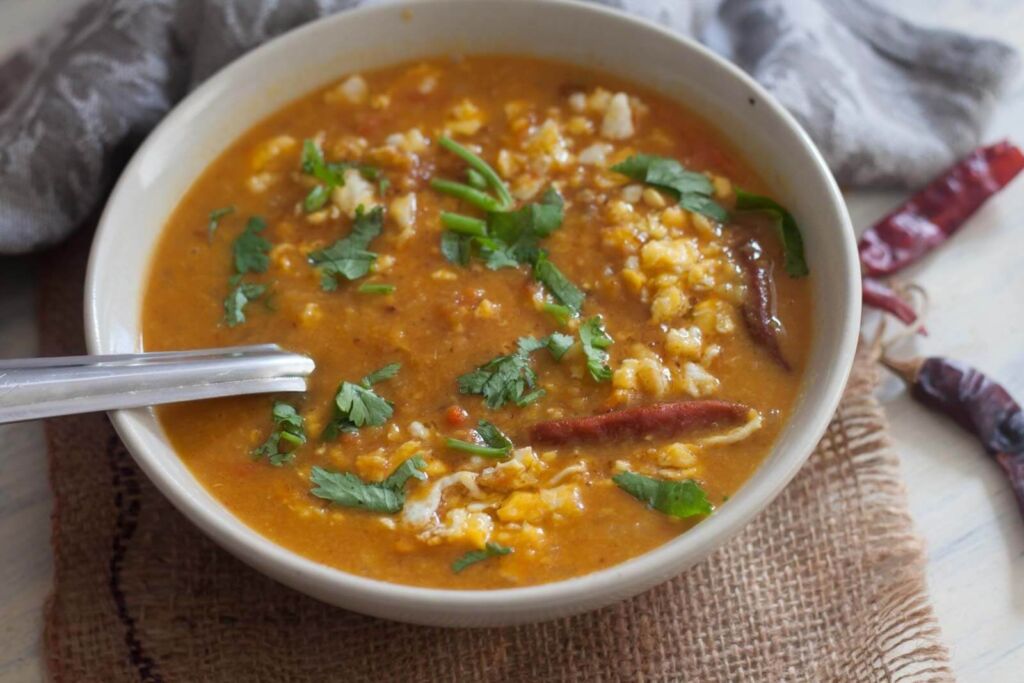
Another addition is a vegetable preparation, usually made of several vegetables that are slowly simmered together without added water. Labra, chorchori , ghonto or chanchra are all traditional cooking styles. There are also plenty of other preparations that don’t fall under any of these categories and are simply called tôrkari – the word just means ‘vegetable’ in Bengali. Sometimes these preparations contain extra pieces of fish, such as pieces of head or gills, or spare portions of meat. A charchari is a vegetable dish that is cooked without stirring, just until charred.
Pickles such as raw mangoes pickled in mustard oil and spices or sweet and spicy tamarind pickles and lemon pickle are also served with the dal course. A variety of pickles are a regular part of the Bengali meal.
Main dish
Fish
A traditional Bengali fish meal – rice with macher jhol (literally translated to “Fish gravy”). Bengals eat numerous amounts of fish and usually seek fresh water and brackish. They also temper it with phoron.
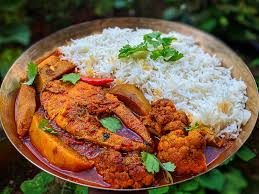
Meat
Then comes the meat course. The divide between the Bengalis of Bangladesh and West Bengal is most apparent when it comes to the meat course because of the Hindu principle of ahimsa which prohibits meat consumption. However, Bengali Hindus are fond of eating goat, chicken, duck and lamb meat. Most Hindus do not eat beef. Meat, especially beef, is easily consumed in Bangladesh and is considered the main dish of the meal. Various types of beef, mutton and chicken are served at parties and banquets. Since beef consumption is banned among Hindu Bengali communities, Khasi mutton is traditionally the preferred meat in West Bengal, but murgi chicken and đim eggs are also commonly consumed. At the time of the partition, it was rare for caste Hindus to eat chicken or even eggs from hens, preferring to choose duck eggs as eggs to be consumed. While it is questionable whether chicken is more popular than khasi in West Bengal today, the proliferation of poultry farms and hatcheries makes chicken the cheaper alternative.
Chutney
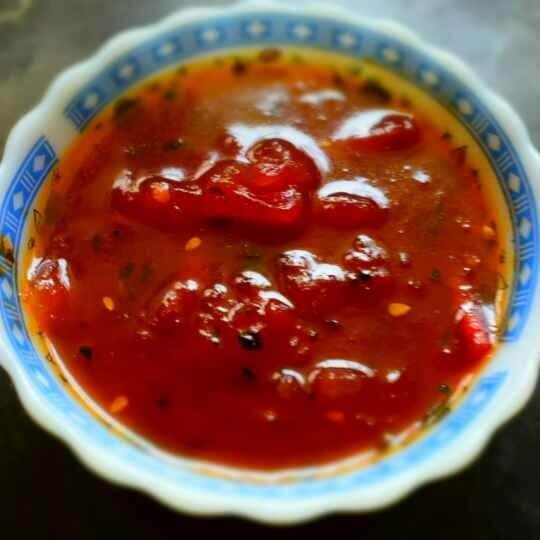
Next comes the chutney course, which is typically spicy and sweet; the chutney is usually made from am mangoes, tomatoes, anarôsh pineapple, tetul tamarind, pepe papaya, or simply a combination of fruits and dried fruits, called mixed fruit chutney, served in biye badi (wedding ceremony). The chutney is also the move to the sweeter part of the meal and also acts as a seasoning, similar to serving sorbet in some western cuisines.
Papoŗ (papadum), a type of wafer, thin and flaky, is often made from đal or potatoes or shagu (sago) and is a common accompaniment to chutneys.
Dessert
Mishti Doic
The last item before the candies is doi (yogurt). It is generally of two types, either natural flavor and taste or Mishti Doi – sweet yogurt, usually sweetened with charred sugar. This ensures a brown color and a distinct taste. Like fish or sweets, mishti doi is typically identified with Bengali cuisine.
With a daily meal it is likely that some of the courses will be missed, for example the ‘Shak’, the complementary course, chutney and papor. In some cases, dessert can also be missed. The courses are generally the same at home or at a social function (eg wedding party). Rice, the main ingredient of the meal, is replaced by ‘luchi’ or luchi filled with dal or mashed green peas. The substitution is a relatively recent phenomenon and has only been seen in practice from about the beginning of the 20th century.
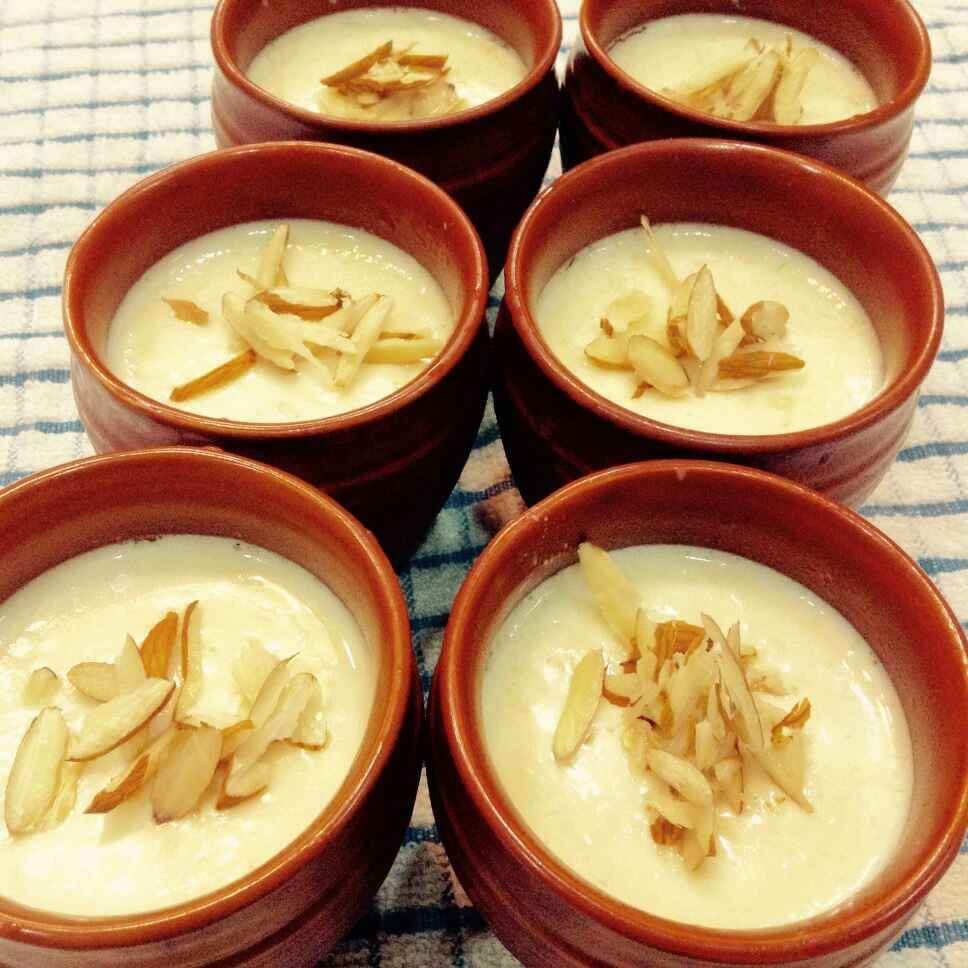
Sweets or mishti occupy an important place in the Bengali diet and in their social ceremonies. It is an old custom among both Hindu and Muslim Bengalis to hand out sweets during festivities. The confectionery industry thrives thanks to its close connection to social and religious ceremonies. Competition and changing tastes have contributed to the creation of many new sweets, and today this industry has grown both in the country and around the world.
Bengali sweets have a long history. The Portuguese monk Sébastien Manrique, traveling through the region in the 17th century, noted the multitude of milk-based foods and sweets prepared in traditional ways.
Bengali sweets are generally made from sweetened curd (chhena), unlike the use of khoa (reduced congealed milk) in northern India. Flour from various grains and legumes are also used.
Made from sweetened, finely ground fresh chhena (curd cheese), shôndesh in all its varieties is one of the most popular Bengali sweets. The basic shôndesh has been greatly improved by the many famous confectioners of Bengal, and now hundreds of different varieties exist, from the simple kachagolla to the complicated abar khabo, jôlbhôra or indrani. Another variation is the kôrapak or hard mixture, which mixes rice flour with the paneer to form a shell-like dough that lasts much longer.
Laddu (or as it is known as “darbesh” in Bengal) is a common sweet in West Bengal and Bangladesh as well as the rest of the subcontinent, especially during celebrations and festivities. They are usually made of flour, ghee/butter/oil and sugar. Alternative recipes can be made from coconut shavings and jaggery, raisins, chopped nuts, oatmeal, khoa, nutmeg, cardamom, or poppy seeds, among other ingredients. The candy dates back to 4 BCE, where it was used for medicinal purposes and to “control” the hormones of 9-11 year old girls.
Ras malai is composed of white, cream or yellow colored balls of channa dipped and soaked in sugar and malai or curd cheese. This dessert resembles rasgulla. Although it is not primarily Bengali sweet and originated from other places, Ras Malai is still very popular.
Pantua is somewhat similar to the rôshogolla, except the cottage cheese balls are fried in ghee (clarified butter) or oil until golden brown or deep brown before being put in syrup. There are similar, but differently shaped versions of the Pantua, for example Langcha (cylindrical) or Ledikeni. Pantua is similar to gulab jamun and could be called a Bengali variant of that dish.
Chômchôm (originally from Porabari, Tangail District in Bangladesh) goes back about 150 years, except that many variants of this Bengali dish are now available. It can also be kept longer. Granules of mawa or dried milk can also be sprinkled on top.
In both Bangladesh and West Bengal, the tradition of making various types of fried, steamed or boiled sweets, fondly known as pithe or the “pitha“, is still thriving. These symbolize the arrival of winter and the arrival of a season when rich foods can be included in the otherwise mild diet of the Bengalis. Its richness lies in the creamy silky milk that is often mixed with molasses, or cane sugar made from date palm or sugar cane, and sometimes sugar. They are usually divided into different categories based on how they are made. Generally, rice flour is used for making the pithe.
They are usually fried or steamed; The most common forms of these cakes include bhapa piţha (steamed), pakan pitha (fried), and puli pitha (dumplings). The other common pithas are chandrapuli, gokul, pati shapta, chitai pitha, aski pithe, muger puli and dudh puli.
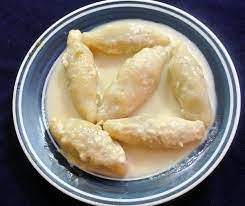
The Pati Shapta variety is basically a thin layer of rice flour pancakes with a milk custard creme filling, similar to the hoppers or appams of South India, or French pancakes. In urban areas of Bangladesh and West Bengal, most homes hold Piţha festivals, such as Nabanna.
Snacks
Muŗi (puffed rice) is made by heating sand in a pot and then throwing grains of rice into it. The rice may have been brine washed to flavor. The rice inflates and is separated from the sand by a sieve. Muŗi is very popular and used on a wide variety of secular and religious occasions, or even simply consumed. Muri is also often used as a substitute for or in combination with regular rice. A variant of muŗi is khoi, which is puffed rice. Both types are used to make many different snacks.
One of Bengal’s most popular and iconic snacks, jhal literally means ‘hot’ or ‘spicy’. Jhal-muŗi is puffed rice with spices, vegetables and raw mustard oil. Depending on what is added, there are many types of jhal-muŗi, but the most common is a bhôrta made from chopped shallot, jira roasted ground cumin, bitnoon black salt lôngka/morich chilis (either kacha ‘ripe’ or shukna ‘dried’ ), mustard oil, dhone pata (fresh coriander leaves) and mudhi.
A moa is made by taking muri with gur (cane sugar) as a binder and making it into a ball, which is made all over Bengal. Another popular type of moa is Jaynagarer Moa, a moa mainly made in Jaynagar that uses kanakchur khoi and nolen gur as a binding agent. Nolen gur is fresh cane sugar made from the juice of date palm. Moas are specially made in the winter.
Chir̦e Bhaja consists of flattened rice fried in sand and then sieved in metal sieves, not a tea strainer. It is usually consumed with fried peanuts, jhuri-bhaja and fried curry leaves.
Shingara or Samosa is a snack made with potato and flour. This triangular dish is made by making a cone of flour and pouring the boiled potato into it and then it is cooked in hot oil.
Mezban
Mezban (known locally as Mejjan) is the Bengali word for celebrations for special occasions in the Chittagong region of Bangladesh. The word “Mezban” in Persian means host and “Mezbani” means to host or organize a party for the guests. Historically, Mezbani is a traditional regional festival where people are invited to enjoy a meal of white rice and beef, among other dishes. It is held on such occasions as the anniversary of death, anniversary of birth, celebrating successes, starting a new business, entering a new home, the birth of a child, marriage, aqiqah and circumcision, girls’ ear piercings and naming. of the newborn. The invitation of the Mezban ceremony generally remains open to everyone and different people in different places and neighborhoods convey the invitation to the party. In urban areas, attending a mezban is by invitation only. A Mezban takes place from morning to noon.
Traditionally, for Muslim Bengalis, beef-based dishes are preferred and even a symbol of social prestige for a Mezban celebration. The rich and the poor organize feasts on various occasions, as circumstances permit. It has a distinct cooking style and real Mezban meat requires a certain skill. For example: The unique beef curry served at this festival is known as Mezbani gosht, which contains a distinctive recipe, the knowledge of which is mainly limited to the Chittagonian cooks.
Fish is used instead of beef in the cooking of Mezban in Hindu tradition. The Hindu community of Chittagong organizes Mezbani every year under the banner of “Chittagong Parishad”, with curries made from fish, vegetables and dried fish.


